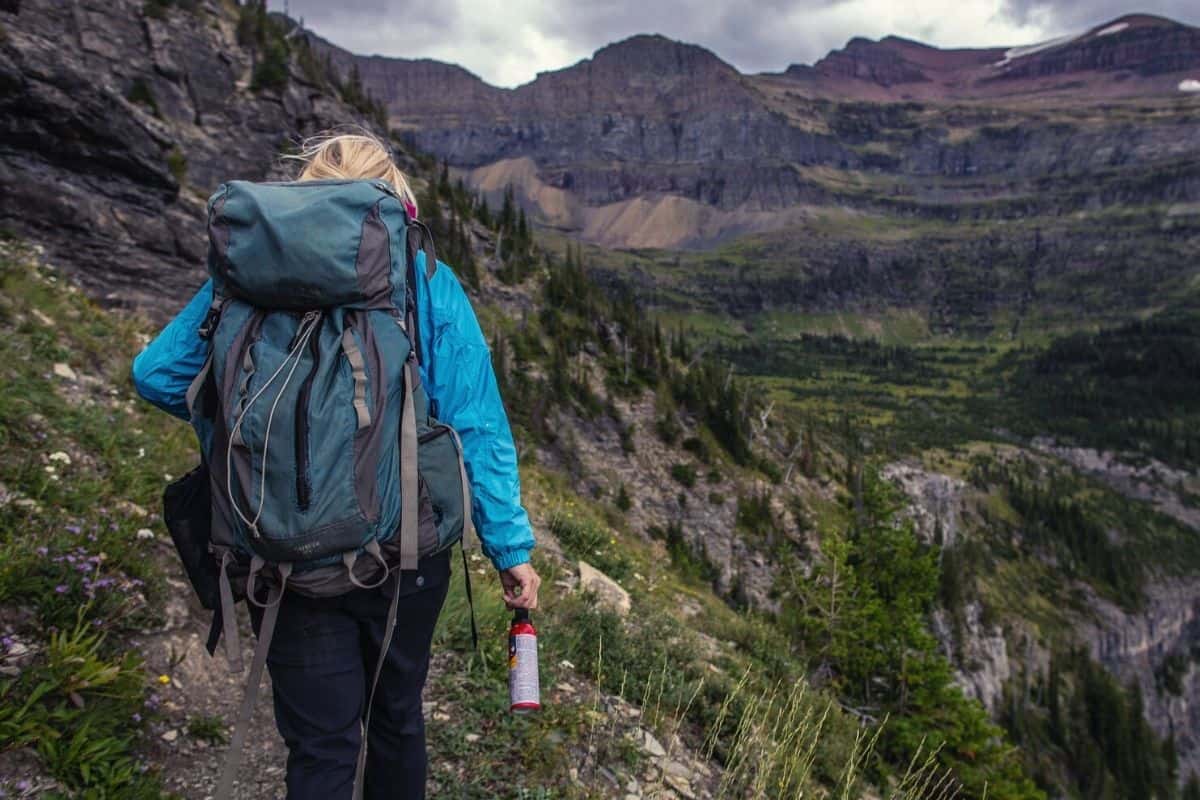Few hikers ever forget their first encounter with a bear. Whether a black bear, a grizzly bear, or any other kind, the big furry fellas leave the kind of lasting impression that only they and Hannibal Lecter are capable of.
But psychological impressions are one thing, physical ones are a completely different story…
The peeps here at My Open Country all have one thing in common when we’re hiking or camping in bear country: making a can of bear spray the first item on our packing list. The reasons for this are simple and something we’ll go into in greater detail about.Below, we’re going to look at why bear spray works, what to look for in a good product, and how to use bear spray if and when the time comes. We’ll also touch on safe storage tips and how to avoid a bear encounter in the first place.
How To Use Bear Deterrent Spray: 7 Simple Steps
Practice makes perfect, and there are two main things you’ll want to practice with your bear spray: removing it from the holster and deploying it.
In theory, it’s a simple process but remembering what to do when a bear charges at you can make fools of us all. That is why practice is imperative. It is highly recommended to buy a practice can or two to get used to what this stuff does and how it handles, and to practice smoothly retrieving it from your holster.
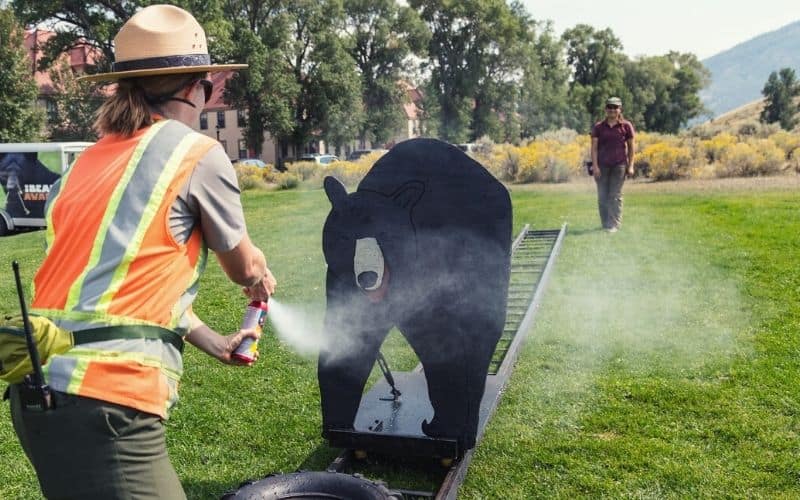
Practice these steps when conditioning yourself on how to safely use a bear deterrent:
- Remove the can from the bear spray holster.
- Remove the safety cap and safety tab.
- With a steady grip, point the can towards the target.
- Aim slightly above the bear’s face (the spray naturally drops) and account for wind direction.
- Hold the canister firmly and press the trigger in short bursts of around two to three seconds. Only start spraying when the bear is about 25-30 feet away (the aim is to put a cloud of spray between you and the bear)
- DO NOT empty the can in one spray. You may need to apply a second dose if the first one is ineffective. If the bear isn’t stopped by one burst, spray again.
- When the animal retreats or is busy trying to rid itself of the irritating chemical invading its respiratory system, leave the area promptly and get yourself to a safe location.
Watch the excellent video by Parks Canada to see exactly what to expect when using bear spray.
Extra Tips For Using Bear Spray
- Most bear sprays aren’t cheap, but they can potentially save your life. Make sure to bring two cans per group of hikers, even if you’re the only one out there.
- Consider the wind speed and direction before you spray your can – getting a faceful of the stuff, we promise you, won’t be fun
- These sprays are effective at keeping bears away, but won’t keep the bear occupied for long. It’s imperative to get out of the area (without running) as soon as the bear is incapacitated.
- Holding the can in two hands is preferable to one, when you can, to steady your hand and ensure accurate aiming.
- DO NOT use the bear deterrent as a repellent (by spraying it on your tent or around your campsite, for example). It doesn’t work and has been shown to actually attract animals.
- Store bear spray in a safe but readily accessible place at camp.
- Never point the can at others or yourself. (That shouldn’t even need to be said, but kids are eating laundry detergent, so…)
- If hiking/camping in a national park, make sure carrying bear spray is permitted by calling ranger stations, visitor centers, or backcountry offices ahead of time.
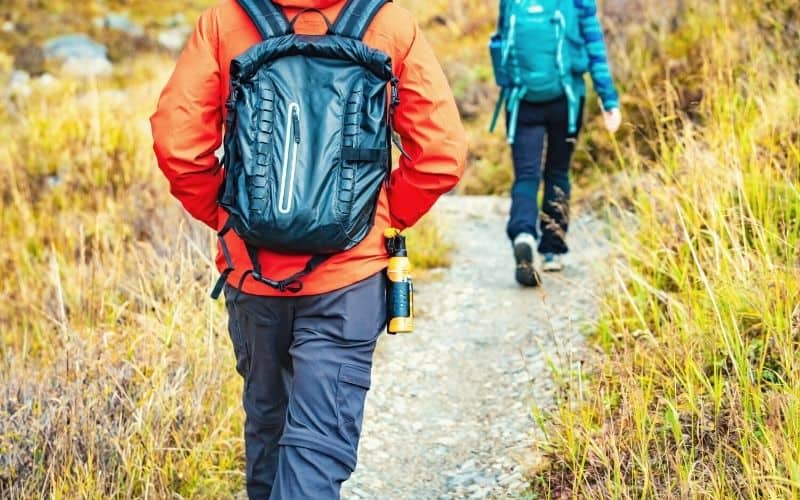
Where is Bear Country?
In North America, bears can be found in many areas, but their populations are largely centered in forests, especially in the wilderness areas west of the Rockies. However, bears are venturing further from their forested abodes as suburbs encroach on their remaining habitat.
Bear attacks are infrequent, but when they do set their sights on a target, it usually goes in their favor.
How infrequent are attacks? That can be a difficult number to accurately assess. Fatal attacks are unfortunately easier to tally. In the 2000s in North America, 46 fatalities have been reported (27 in the United States and 19 in Canada). On average it’s about three fatalities a year.
How Bear Spray Works
Essentially bear spray is a giant can of concentrated pepper spray, the active ingredient in “bear mace” is oleoresin capsicum. That’s the stuff that makes a red pepper hot and spicy. Ever cut jalapeno or habanero peppers and accidentally rub your eye? That’s the G-rated preview of what a spray feels like.
What Does Bear Spray Do?
A concentrated pepper spray irritates mucous membranes and other sensitive areas like the mouth and ears. The material becomes aerosolized and forms a cloud of burning vapor. If spray hits the eyes, it can cause temporary blindness. The stuff wears off in about twenty minutes, leaving a blurry-eyed bear wondering where those thousands of stinging bees came from.
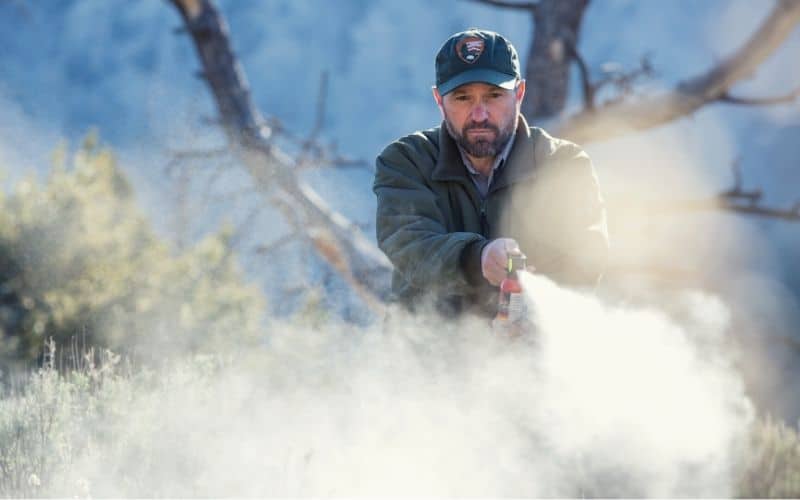
Bear Deterrent Spray Versus Firearms
Statistically, bear spray is far more effective than firearms to deter bears. Bears can run at speeds up to 30 miles per hour (yikes!), making personal defense with firearms difficult at best. Additionally, it takes 3 to 4 bullet wounds to kill a bear.
Spray, on the other hand, is easier to use, attacks more broadly, and is not fatal. I’m not about to break into a Disney song here, but when we’re in bear country, we’re in the bears’ home. If we can simply deter the bears instead of killing them, we should.
If we’re looking simply at numbers, sprays work over 90% of the time.
What To Look For In A Good Bear Spray
All sprays are regulated by the EPA and have a standard concentration of active ingredients, so while “stronger” is a useful trait, we’re looking primarily for spray distance, spray duration and quantity, and ease of accessibility.
Spray Distance
The farther a spray reaches, the better chance you have of stopping a charging bear before it reaches you. The best sprays reach distances of 30 feet. At a minimum you want something that can spray 15 feet; anything less than that and you’re liable to stand in a cloud of the stuff yourself.
One of our go-to sprays is the Counter Assault 8.1 oz., which has a range of 32 feet or the 10.2 oz. option which has a range of 40 feet.
Spray Duration and Capacity/Quantity
Even when sprayed accurately, a longer duration means more deterrent which equals a better chance of making it through an ursine encounter gone bad. The best sprays on the market spray for nearly 10 seconds. You shouldn’t accept anything less than a 7-second duration.
The more, the better. You want a can no smaller than 8 ounces.
Accessibility And Safety Features
What good is a deterrent if you can’t reach it? The biggest mistake people make when using a bear spray is storing it in their backpack where they can’t reach it when need be.
The best bear sprays will come with an included holster allowing you to store the can on your belt or the straps of your pack, like a water bottle holder. You want to channel John Wayne’s quickdraw when using the spray; the faster it’s in your hands, the faster it’s ready.
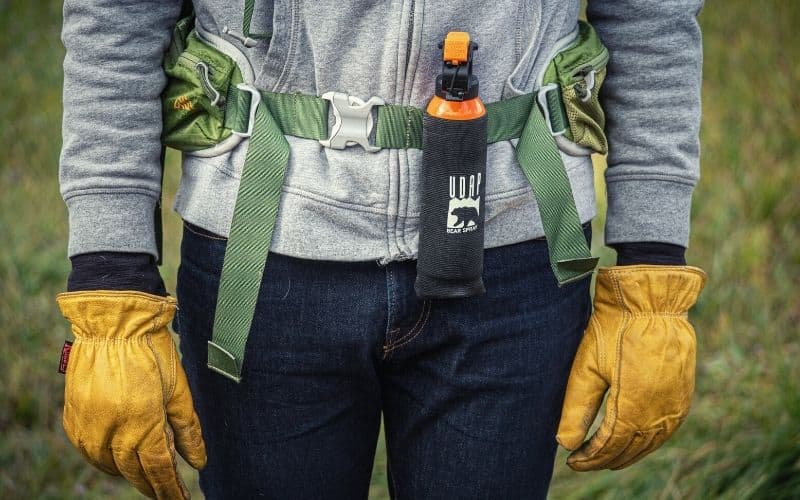
Accessibility ties in with safety features. Most sprays will have a glow-in-the-dark indicator of where the applicator is pointed, but the best have a handle that prevents it from being gripped the wrong way. Pointing the can at yourself instead of the animal is not only embarrassing, but it’s also potentially deadly.
Avoid Encounters In The First Place
“An ounce of prevention is worth a pound of cure”.
Most bears are shy creatures. They’re naturally afraid of any perceived threat and would rather bound off to safety than risk an injury or confrontation. Survivors of many attacks report that they stumbled upon the bears and surprised each other; in a moment of panic and territoriality, the bears attacked.
The take-home from this is that your chances of happening upon a predatory bear are slim, and the greatest safety precaution you can take is making the bear aware of your presence to avoid surprising it.
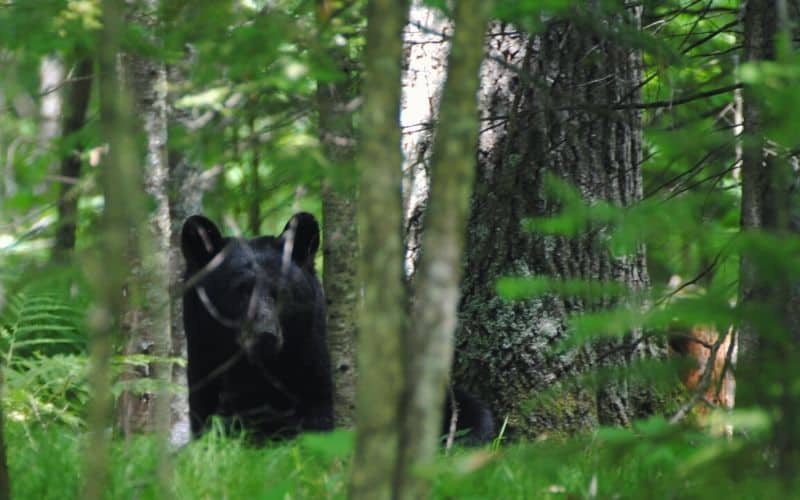
To avoid an encounter:
- Make Noise. A loud conversation, crunching sticks in your path, or wearing a bell might kill the zen vibe, but it lets bears know you’re in the vicinity.
- Avoid Ursine Hangouts: Watch for and avoid places where bears are likely to be, like berry patches and streambeds.
- Store Food Safely: If possible, hang your food from a tree branch. Shoot for about fifteen feet off the ground, and about five feet from the trunk of the tree.
- Use Common Sense: Store your food safely in bear-proof canisters or keep it as far away from your campsite as possible. Experts recommend 100 yards, but that’s simply not possible all the time. Simply put: the farther the better. Be sure to keep food wrappers, containers, and dirty plates away from your camp too.
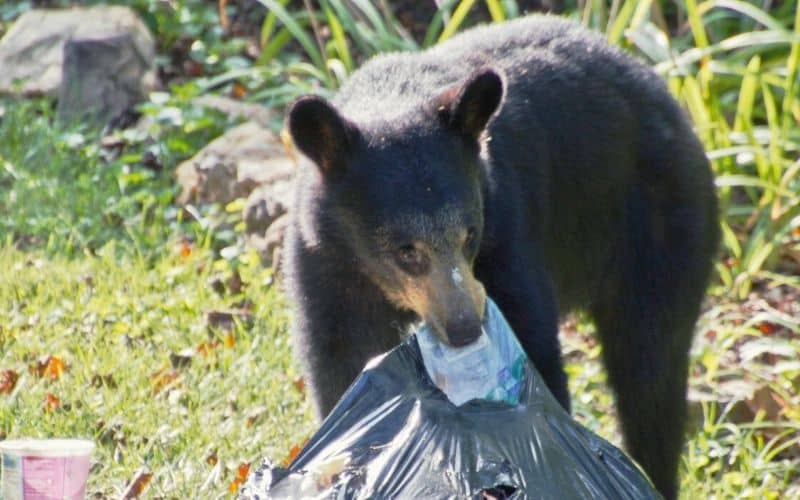
How to Carry Bear Spray
Deterrent canisters for bears should always be carried on your hip for easy access. When a bear’s bearing down on you at 30 miles per hour, having it in your pack is going to be of no use whatsoever.
Always ensure the can is safely stored in a holster and that all safety caps are in place.
How Long Does Bear Spray Last & How Do You Store It?
The average bear spray canister has a shelf life of four years, so you need to replace it after that time. During that time, store it in a cool, dry place. Avoid extreme temperatures (32° to about 110° Fahrenheit) always.
Never puncture the can. Some types of spray are incredibly flammable. For that reason, keep the can out of direct sunlight whenever possible.
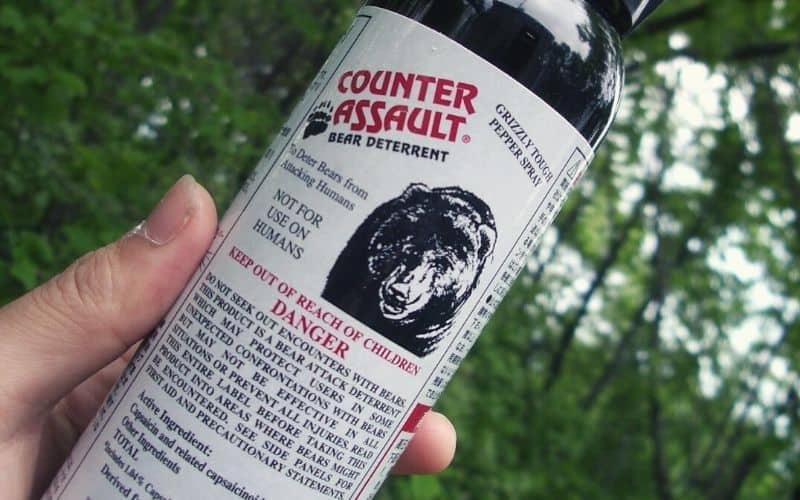
Accidental Contamination
Accidents happen. Maybe the can discharges, or you have it go off in your car. So, what do you do in case of accidental contact?
Prepare yourself to experience an intense burning sensation on any exposed flesh that comes into contact with the spray and the excruciating pain that comes when it contacts your eyes, nose, and mouth. After about 15-20 minutes the worst of it goes away if you follow these guidelines:
- Avoid rubbing, touching, and scratching any areas with your hands as much as possible to prevent spreading the stuff even further around your body
- Get as much of the spray off without touching yourself as possible (use leaves, clothing, etc.)
- Liberally and frequently rinse the stuff off with cool, clean water
- Take short breaths of fresh air
- If you wear contact lenses then remove them
- Wash your clothing as soon as you can
Recycling Bear Spray
Don’t just throw that can away! That’s irresponsible, come on, now.
Some parks like Yellowstone will have recycling bins for bear sprays. If you don’t have access to one you’ll want to call your county or city’s waste management facilities and ask for the preferred method.
How to Use Bear Spray: Wrapping Up
Bear spray canisters are powerful tools to use against the potentially fatal threat of bears. The sprays are humane, relatively inexpensive for the level of safety they provide and are incredibly effective in stopping a charging bear in his/her tracks. They’re also easy to use with a little practice and safe to store if you aren’t subjecting the cans to extreme temperatures.
Next time you head out into bear country, be sure to bring a handy can of pepper power with you…your life might just depend on it.
Now as my parting gift to you, no discussion on ursine safety is complete without the wisdom of Dwight Schrute. Enjoy his PSA, and look forward to the next feature on My Open Country.
How did you like our post? If you have any questions or comments, drop us a line in the box below. And if you’d like to share this post on social media, please do so!
